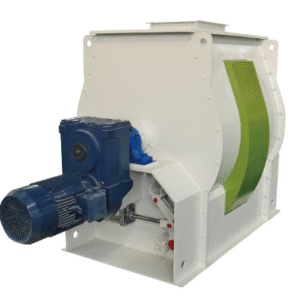Description
Core Technical Specifications Analysis
Drive System Configuration
-
Power range: 5.5-160kW (adjustable based on capacity and material characteristics)
-
Speed regulation: 20-80rpm stepless speed variation
-
Torque output: Heavy-duty gearboxes specifically designed for high-viscosity materials
Scientific Paddle Arrangement
-
Angle combination: Multi-angle paddle configuration at 45°/90°/135°
-
Material selection: Carbon steel/304/316L stainless steel & special wear-resistant alloys
-
Clearance control: Paddle-to-shell clearance ≤2mm ensures zero residue
Discharge Performance Metrics
-
Full-length pneumatic discharge door design
-
Discharge time: 3-5 seconds (2-ton capacity)
-
Residual rate: <0.1%
Industry Application Performance Data
Feed Processing Sector
A 200,000-ton annual capacity feed manufacturer documented post-upgrade results:
-
Mixing uniformity CV value improved from 12% to 4.5%
-
Batch mixing time reduced from 6 to 3.5 minutes
-
Annual power consumption decreased by 35%
-
Trace element addition accuracy reached 99.2%
Building Materials Performance
Dry-mix mortar production line measurements:
-
Fiber dispersion qualification rate: 99.8%
-
Pigment distribution uniformity: 98.5%
-
Equipment failure rate: <1%
-
Capacity increase: Daily batches rose from 80 to 125
Food & Pharmaceutical Applications
GMP-compliant design delivers:
-
Cleaning time reduced by 60%
-
Cross-contamination risk lowered to 0.01%
-
Active ingredient loss rate <0.5%
-
Validation batch qualification rate: 100%
In-Depth Economic Benefit Analysis
Return on Investment Calculation
Example: 50,000-ton annual premix production line:
-
Equipment investment: $120,000
-
Annual savings:
-
Electricity: $17,000
-
Labor: $11,000
-
Material waste: $35,000
-
Quality claim reduction: $42,000
-
-
Payback period: Approximately 1.2 years
Operational Cost Optimization
-
Maintenance intervals extended to 2,000 hours
-
Wear part lifespan increased 3-fold
-
Downtime due to failures reduced by 80%
-
Equipment utilization rate reached 92%
Technological Innovation Trends
Intelligent Mixing Systems
Next-generation equipment features:
-
Real-time torque monitoring
-
Online moisture detection
-
Automatic formula recognition
-
Remote maintenance interfaces
Multi-functional Integrated Design
-
Liquid addition systems
-
In-line sampling devices
-
Automated cleaning functions
-
Vacuum protection configuration
Materials Science Breakthroughs
-
Nano-coating technology
-
Special wear-resistant materials
-
Food-grade composite materials
-
Anti-static design features
Future Outlook & Development Pathway
As new materials and processes continue to emerge, twin-shaft mixers are evolving toward greater precision, intelligence, and environmental sustainability. In emerging fields such as new energy materials, specialty chemicals, and functional foods, this mixing technology will continue to play a critical role.
From laboratory research to industrial production, from traditional sectors to strategic emerging industries, twin-shaft mixers—with their exceptional performance and reliable quality—are providing solid technical support for the transformation and upgrading of global manufacturing.




Reviews
There are no reviews yet.